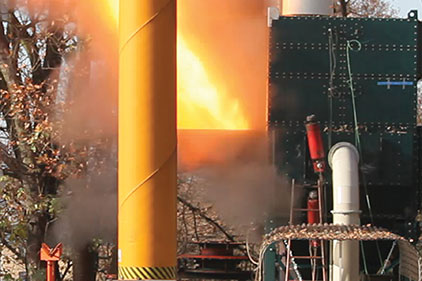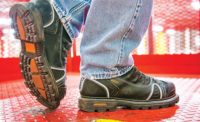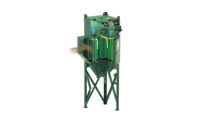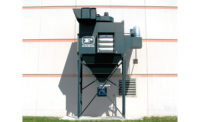Cartridge dust collection systems are the preferred technology for capturing most dry industrial dusts, and there are many different pleated filter cartridges available for these collectors. As you face stricter air quality and combustible dust regulations, choosing the best dust collector filters for your plant is more important than ever.
Following are six tips that can help you determine the best filter for your application:
1. Understand the different measures of filter efficiency and how to apply them.
Dust collector filter manufacturers use different methods to express filter efficiency. Gravimetric analysis is based on particle capture by weight: For example, filter efficiency might be stated as 99.995 percent on particles of 0.5 µm or larger by weight. Filter efficiency may also be expressed as a Minimum Efficiency Reporting Value or MERV, based on a scale from 1 to 16, with MERV 16 being the highest efficiency.
The MERV scale was developed for the HVAC filter market and does not take into account the way a dust collector operates. Though MERV and gravimetric efficiency ratings are useful tools for comparing filters, you should not rely on these measures alone to determine efficiency. It is more relevant to make sure you are satisfying OSHA or EPA requirements for filter performance – OSHA if you are discharging the air and recirculating it indoors downstream of the collector; the EPA if you are discharging the air outside or into the environment.
Mass density efficiency, defined as the weight per unit volume of air, is the best predictor of a filter’s OSHA compliance. For example, OSHA might require that emissions will not exceed 5 milligrams per cubic meter at the discharge of the dust collector. Ask your filter supplier to provide a written guarantee of performance stating that the filters will satisfy applicable emission requirements.
2. Test your dust.
Bench testing involves a series of tests that determine the particle size, shape and characteristics of the dust, moisture content and other properties. These tests can help determine the optimal filter choice as well as design of other dust collection system components.
To determine whether a dust is combustible, it should undergo separate explosibility testing as stated in NFPA Standard 68. Using your dust sample, the lab will start with a screening test to determine whether the dust is combustible. If it is combustible, the lab will conduct further testing on dust cloud parameters to pinpoint the Kst (defined as the deflagration index of a dust cloud, or rate of pressure rise) and Pmax (the maximum pressure in a contained explosion).
Explosibility testing is performed primarily to help determine what explosion protection or prevention equipment is needed on your dust collector and related components. But it can also play a role in filter selection. For example, testing for the minimum ignition energy can help determine if conductive filters are needed.
3. Consider special performance requirements.
Flame-retardant media are treated with a chemical that provides fire-retardant properties for use where there is a risk of fire or explosion. Companies involved in metalworking processes such as plasma and laser-cutting, grinding or welding commonly use filters with flame-retardant media.
Conductive or anti-static filters may be used where conveyed dusts generate static charges that require dissipation. Typically, static dissipation is achieved by impregnating a filter with a carbon coating or aluminized coating. Applications for these filters include fumed silica dust; plastic, PVC or composite dusts; and carbon black/toner dusts. Cartridge filters with anti-static media can also be used in explosive dust applications, as above, making it possible to conform to NFPA requirements and lessen the risk of ignition sources due to static electricity charges.
4. Evaluate total cost of ownership.
When choosing between two cartridge filters with the same rated efficiency, some purchasers will simply choose the lowest-priced filter. But initial cost is only one factor, and it requires a “Total Cost of Ownership” (TCO) evaluation to make the best filter selection.
TCO helps you determine what it really costs to own your dust collector filters by calculating all the components of true filter cost: energy, consumables, and maintenance and disposal. A reputable filter supplier should have software to help you perform the calculations. The TCO evaluation will ultimately save you money, time and energy by ensuring the most cost-effective filter choice.
5. Consider using a nano fiber media.
Nano fiber filter media have been gaining in popularity. When a layer of nano fibers is applied on top of the base media, the nano coating promotes surface loading of fine dust, preventing the dust from penetrating deeply into the filter’s base media. Though these filters carry a cost premium, they offer higher filtration efficiencies as well as better energy performance, superior cleanability, and greater resistance to wear and tear from pulse-cleaning.
A TCO analysis (above) might be worthwhile to find out if the added cost of nano fiber media will be more than offset by resulting savings in energy and filter change-out and disposal costs. In a system operating at very high airflow, for example, a half-inch reduction in pressure drop achieved with a nano fiber filter can make a huge difference in energy consumption.
6. Look for a uniform wide pleat media design.
Many filter manufacturers add filter media to the point where the pleats are so tightly packed that when dust gets between the pleats, the reverse pulse cleaning system of the dust collector will not eject the dust from the pleats. This increases the resistance of the air through the filters and diminishes airflow. The key is to use a wide pleat where 100 percent of the media is usable. A uniform wide pleat filter allows the collected dust to release from the filter, keeping the resistance lower through the filter for a longer time.




